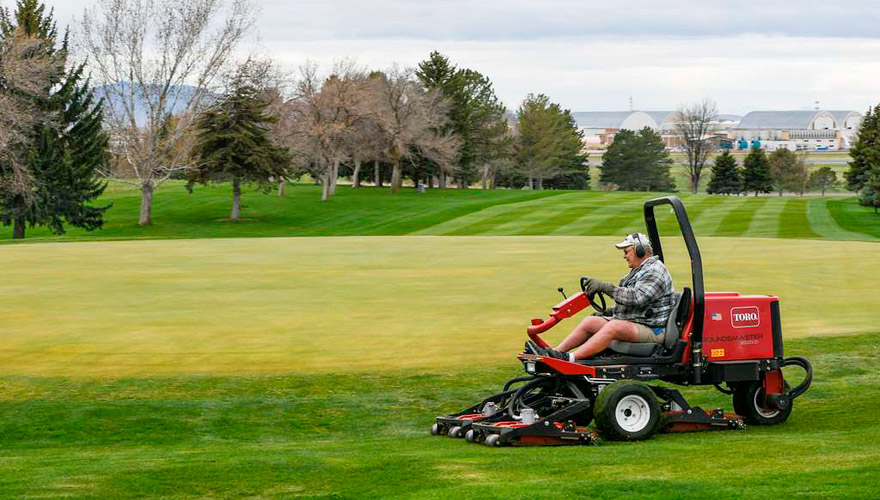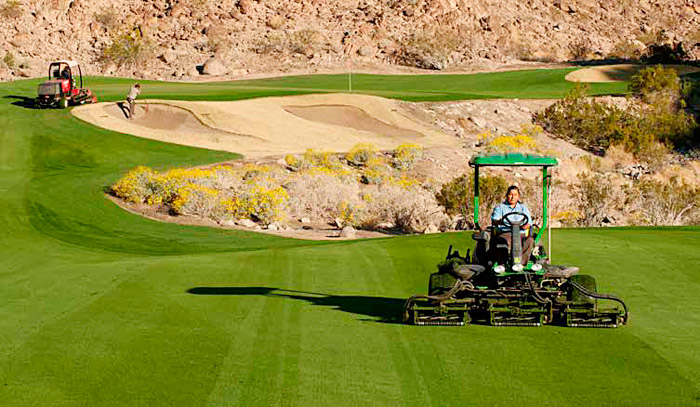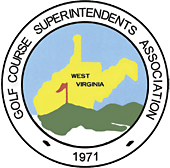Cultural Practices

Cultivation practices are an important part of golf course turf management. Certain cultural practices such as mowing, verticutting, and rolling are necessary to provide a high-quality playing surface, while others such as aerification are required to enhance plant health.
Heavily used areas such as putting greens often deteriorate because of compacted soil, thatch accumulation, and excessive use. Soil problems from active use are usually limited to the top 3 inches of the soil profile and should be actively managed to enhance turf health and improve nutrient and water uptake.
Unlike annual crops, which offer the opportunity for periodic tilling of the soil profile to correct problems like soil compaction that might develop over time, turfgrass does not offer opportunities for significant physical disturbance of the soil without destroying the playing surface.
Mowing
Principles
- Mowing is the most basic yet most important cultural practice to consider when developing a management plan.
- The mowing practices implemented on a facility will have an impact on turf density, texture, color, root development, and wear tolerance.
- Mowing practices affect turfgrass growth. Frequent mowing will increase shoot density and tillering. It will also decrease root and rhizome growth as a result of plant stress associated with removal of leaf tissue.
- Infrequent mowing results in alternating cycles of vegetative growth followed by scalping, which further depletes food reserves of the plants.
- Proper mowing height is a function of the species/cultivar being managed and the intended use of the site. Other factors influencing mowing height include mowing frequency, shade, mowing equipment, time of year, root growth, and abiotic and biotic stress.
- Maintaining an optimal root-to-shoot ratio is critical. Turfgrass plants that are mowed too low will require a substantial amount of time to provide the food needed to produce shoot tissue for future photosynthesis. If turf is mowed too low in one event, an imbalance occurs between the remaining vegetative tissue and the root system, resulting in more roots being present than the plant needs physiologically. As a result, the plants will slough off the unneeded roots. Root growth is least affected when no more than 30% to 40% of leaf area is removed in a single mowing.
- Failure to mow properly will result in weakened turf with poor density and quality.
Best Management Practices
- Mowing frequency should increase during periods of rapid growth and decrease during dry, stressful periods.
- If turf becomes too tall, it should not be mowed down to the desired height all at once. Such severe scalping reduces turf density and can result in a dramatic reduction in root growth. Tall grass should be mowed frequently and height gradually decreased until desired height of cut is achieved.
- Shade affects turfgrass growth by filtering out photosynthetically active radiation. As a result, turfgrass plants respond by growing upright in an effort to capture more light to meet their photosynthetic needs. As a result, mowing height should be increased by at least 30% to improve the health of turf grown in a shaded environment.
- The use of the plant growth regulator trinexapac-ethyl has been shown to improve overall turf health when used as a regular management tool for grasses growing in shaded environments.
- Environmental stresses such as prolonged cloudy weather or drought can have a significant impact on turf health. Increase mowing heights as much as use will allow in order to increase photosynthetic capacity and rooting depth of plants.
- Use proper mowing equipment.
- Reel mowers are ideally suited for maintaining turfgrass stands that require a height of cut below 1.5 inches. They produce the best quality when compared to other types of mowers.
- Rotary mowers, when sharp and properly adjusted, deliver acceptable cutting quality for turf that is to be cut above 1 inch in height. Dull blades will result in shredding of leaf tissue, increasing water loss and the potential for disease development.
- Flail mowers are most often used to maintain utility turf areas that are mowed infrequently and do not have a high aesthetic requirement.
- Mowing patterns influence both the aesthetic and functional characteristics of a turf surface.
- Turfgrass clippings are a source of nutrients, containing 2% to 4% nitrogen on a dry-weight basis, as well as significant amounts of phosphorus and potassium.
- Nutrients contained in clippings can be sources of pollution and should be handled properly.
- Clippings should be returned to the site during the mowing process unless the presence of grass clippings will have a detrimental impact on play. Cases when clippings should be removed include times when the amount of clippings is so large that it could smother the underlying grass or on golf greens where clippings might affect ball roll.
- Collected clippings should be disposed of properly to prevent undesirable odors near play areas and to prevent fire hazards that can occur when clippings accumulate. Consider composting clippings or dispersing them evenly in natural areas where they can decompose naturally without accumulating in piles.
Cultivation
Principles
- Cultivation involves disturbing the soil or thatch through the use of various implements to achieve important agronomic goals that include relief of soil compaction, thatch/organic matter reduction, and improved water and air exchange.
- Cultivation techniques will result in disturbance of the playing surface that can require significant time for recovery.
- Frequency of cultivation should be based on traffic intensity and level of soil compaction.
- Core aerification is effective at managing soil compaction and aiding in improvement of soil drainage.
- Accumulation of excessive thatch and organic matter will reduce root growth, encourage disease, and create undesirable playing conditions.
- Light and frequent applications of sand will smooth the playing surface, control thatch, and potentially change the physical characteristics of the underlying soil when done in conjunction with core aerification.
Best Management Practices
- Core aerification involves removal of small cores or plugs from the soil profile. Cores are usually 0.25 to 0.75 inch in diameter. Annual core aerification programs should be designed to remove 15%-20% of the surface area. High-traffic areas may require a minimum of two to four core aerifications annually.
- Core aerification should be conducted only when grasses are actively growing to aid in quick recovery of surface density.
- Vary depth of aerification events by incorporating varying length tines to prevent development of compacted layers in the soil profile as a result of cultivation.
- Solid tines cause less disturbance to the turf surface and can be used to temporarily reduce compaction and soften surface hardness during months when the growth rate of grasses has been reduced. Benefits of solid-tine aerification are temporary because no soil is removed from the profile.
- Deep-drill aerification creates deep holes in the soil profile through use of drill bits. Soil is brought to the surface and distributed into the canopy. Holes can be backfilled with new root-zone materials if a drill-and-fill machine is used. These machines allow replacement of heavier soils with sand or other materials in an effort to improve water infiltration into the soil profile.
- Slicing and spiking reduce surface compaction and promote water infiltration with minimal surface damage.
- Slicing is faster than core aerification but is less effective. Slicing is best accomplished on moist soils.
- A spiker can break up crusts on the soil surface, disrupt algae layers, and improve water infiltration.
- Vertical mowing (verticutting) can be incorporated into a cultural management program to achieve a number of different goals. The grain of a putting green can be reduced by setting a verticutter to a depth that just nicks the surface of the turf. Deeper penetration of knives will stimulate new growth by cutting through stolons and rhizomes while removing accumulated thatch.
- Verticutting depth for thatch removal should reach the bottom of the thatch layer and extend into the surface of the soil beneath the thatch.
- Dethatching with a verticutter is an aggressive practice that is not recommended on golf putting greens because of the damage that occurs and the extensive recovery time required.
- Initiate vertical mowing when thatch level reaches 0.25 to 0.5 inch in depth. Shallow vertical mowing should be completed at least monthly on putting greens to prevent excessive thatch accumulation.
- Groomers, or miniature vertical mowers attached to the front of reels, are effective at improving management of grain and improving plant density through cutting of stolons.
- Topdress the playing surface with sand following core aerification and heavy vertical mowing to aid in recovery of turf. Rates will vary from 0.125 to 0.25 inch in depth and will depend on the capacity of the turf canopy to absorb the material without burying the plants.
- Light, frequent applications of topdressing sand on putting greens can smooth out minor surface irregularities, aiding in the management of thatch accumulation.
- Use only weed-free topdressing materials with a particle size similar to that of the underlying root zone.
- Use of finer materials can result in layering and can have a negative impact on water infiltration.
- Daily rolling of putting surfaces following mowing can increase putting speeds by roughly 10%, allowing for improved ball roll without lowering height of cut.
- To minimize potential for compaction caused by rolling, use light weight rollers.

Overseeding Warm-Season Turfgrass
Principles
- The fundamental purpose of overseeding is to establish a temporary cool-season grass into the warm-season base for improved color and playability during the fall and winter when the warm-season grass enters dormancy.
- Overseeding increases the need for irrigation and routine mowing and may result in significant thinning of the base grass during spring transition.
- Successful overseeding programs require year-long planning and incorporate all aspects of root-zone cultivation and weed control in an effort to maintain health of the warm-season turfgrass while allowing successful establishment of the overseeded cool-season grass species.
Best Management Practices
- Thatch depth greater than 0.5 inch in the warm-season turfgrass base will prevent good seed-to-soil contact and will result in sporadic germination and establishment. Remove thatch as part of an active cultivation program before overseeding.
- Reduce or eliminate fertilization of the base grass three to four weeks before the planned seeding date to minimize growth and competition.
- Core-aerify the soil four to six weeks before the planned overseeding date to open turf canopy and aid in uniform establishment of overseeded grass.
- Select grass species/cultivars that are adapted to the desired use, taking note of disease resistance and spring transition traits. Cultivars with improved heat tolerance can delay spring transition and create increased competition for water, nutrients, and light with the warm-season turfgrass base.
- Irrigate newly planted overseed to maintain constant moisture levels, not allowing the soil surface to dry out. Gradually reduce irrigation once the seedlings have been mowed.
- Do not fertilize with nitrogen immediately before or during establishment of overseed as the N may encourage warm-season turfgrass competition and increase disease potential.
- Move hole locations on putting greens daily during the establishment period to minimize damage to seedlings from foot traffic.
- Reduce fertilizer rates in spring to slow growth of overseeded grass. Once warm-season turfgrass regrowth is apparent, restore fertilizer applications to stimulate growth of the warm-season turfgrass.
- Colorants (dyes and pigments) can be used to provide winter color to dormant grasses.
- Overseeding practices can generate significant dust that may require dust control measures.
Shade and Tree Management
Principles
- In general, most turfgrasses perform best in full sun.
- Excessive shade reduces photosynthesis and air circulation, thus increasing the susceptibility of the turf to pest and disease problems.
Best Management Practices
- Prune tree limbs and roots as needed to reduce competition for sunlight, water, and nutrients.
- When possible, trees located near closely mowed areas such as tees and greens should be removed or their canopy should be thinned to promote good turf growth.
- Understand the variability in sun angles at different times of the year and how this affects turf health.
- Conduct a shade audit to identify problem areas.
- Conduct a tree survey that identifies each tree’s location, species, health, life expectancy, safety concerns, value and special maintenance requirements.




